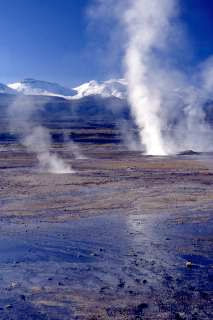 succinctness in the South American Handbook - the Belgian priest Gustavo Le Paige had organized an archaeological museum of the local Atacameño heritage, and there were two places to stay: the Hostería de San Pedro (beyond my backpacker budget) and the modest Residencial Florida (pictured here, now known as "Your Hostal Florida"). I opted for the latter and, at dinnertime, conversed with its only other guest, a Japanese backpacker, in my then rudimentary Spanish.
succinctness in the South American Handbook - the Belgian priest Gustavo Le Paige had organized an archaeological museum of the local Atacameño heritage, and there were two places to stay: the Hostería de San Pedro (beyond my backpacker budget) and the modest Residencial Florida (pictured here, now known as "Your Hostal Florida"). I opted for the latter and, at dinnertime, conversed with its only other guest, a Japanese backpacker, in my then rudimentary Spanish.At that time, excursions such as El Tatio, perhaps the world's highest
 geyser field, were next to impossible because, simply, you needed your own 4WD vehicle to travel the appallingly bad roads and, on a backpacker budget, this was impossible. I settled for walkable nearby sights such as the Pukará de Quitor, a 12th-century fortifications, and the Tambo de Catarpe, and Incaic administrative center. It was more than a decade later, after Chile's return to representative government, that San Pedro began to become the Atacama desert's premium destination for backpackers and, increasingly, upscale foreign tourists.
geyser field, were next to impossible because, simply, you needed your own 4WD vehicle to travel the appallingly bad roads and, on a backpacker budget, this was impossible. I settled for walkable nearby sights such as the Pukará de Quitor, a 12th-century fortifications, and the Tambo de Catarpe, and Incaic administrative center. It was more than a decade later, after Chile's return to representative government, that San Pedro began to become the Atacama desert's premium destination for backpackers and, increasingly, upscale foreign tourists.I visit San Pedro at least every third year, and the changes are ever more breathtaking. The main street, Caracoles, now consists of almost wall-to-wall restaurants and travel agencies that arrange visits to El Tatio and other sights. And, according
 to an information file provided me by the local office of Sernatur, San Pedro now has at least 72 accommodations options, ranging from campgrounds to five-star hotels. Since the installation of the controversial Explora chain about a decade ago, there has been a proliferation of all-inclusive resorts, many of whose staff are Explora alumni. These range from the intimate Hotel Awasi (only eight rooms, and just a short walk from the town square) to the outlying Tierra Atacama and Alto Atacama (pictured here, near the Pukará de Quitor). Many people feel ambivalent about San Pedro's transformation to a tourist economy but, at the same time, it's hard to imagine that things would be better here - economically, at least - without the investment that has taken place. Whether the area's resources, especially its limited water, can handle the growth is another question.
to an information file provided me by the local office of Sernatur, San Pedro now has at least 72 accommodations options, ranging from campgrounds to five-star hotels. Since the installation of the controversial Explora chain about a decade ago, there has been a proliferation of all-inclusive resorts, many of whose staff are Explora alumni. These range from the intimate Hotel Awasi (only eight rooms, and just a short walk from the town square) to the outlying Tierra Atacama and Alto Atacama (pictured here, near the Pukará de Quitor). Many people feel ambivalent about San Pedro's transformation to a tourist economy but, at the same time, it's hard to imagine that things would be better here - economically, at least - without the investment that has taken place. Whether the area's resources, especially its limited water, can handle the growth is another question.

3 comments:
It's so nice blog with informative world development.
I like to read more, keep on updating.
Very nice site. Organized and an eye-pleaser.i am a Indian, will you tell me how I visit San Pedro? actually a online booking agency was promise me that they will arrange a short tour in summer vacation.but now they refuse that.
I'm not sure what you mean by this, Max, but it's easy enough to travel to San Pedro independently. However, I'm not sure whether or not Indian citizens need a visa for Chile.
Post a Comment